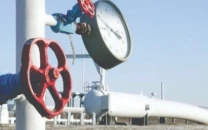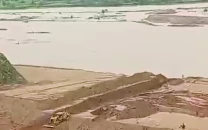Vertical farming: future or fiction?
.

Agriculture, the backbone of Pakistan's economy, is facing mounting challenges, including water scarcity, shrinking arable land, declining soil health and increasingly severe impacts of climate change. While technological advancements have allowed scientists to develop high-yield crop varieties, improved inputs and better management practices suited for suboptimal conditions, the worsening climate crisis and dwindling resources continue to threaten food security and farm yields globally. Moreover, conventional agricultural practices, such as deforestation, flood irrigation, excessive fossil fuel consumption, greenhouse gas emissions and soil degradation, are exacerbating climate change and undermining the sustainability of food production.
In this context, vertical farming has emerged as a revolutionary and sustainable solution. Originally conceptualised for space missions, vertical farming involves growing plants indoors in stacked or vertical layers under controlled conditions. Unlike traditional farming, this method does not require expansive fertile land and can be implemented in urban settings like warehouses, rooftops, or even basements. The core idea of vertical farming is to maximise space efficiency, allowing more plants to grow within a smaller area. Using techniques such as hydroponics, where plants are grown in nutrient-rich water; aquaponics, which combines fish farming with plant cultivation; and aeroponics, where plants are grown in a nutrient mist, vertical farming provides crops with precisely what they need to thrive. Environmental factors such as light, temperature, humidity and CO? levels are carefully regulated to ensure optimal growth.
Although maintaining these controlled environments was once technologically challenging and costly, advancements in affordable cooling systems, solar panels and energy-efficient LEDs have made vertical farming a viable option. While it might initially appear futuristic and expensive, the growing scarcity of resources like arable land, irrigation water and traditional farming inputs highlights the need for this transformative approach. Vertical farming not only reduces the reliance on inputs such as pesticides, fertilisers and soil but also ensures rapid plant growth and higher nutritional value in produce. The absence of soil eliminates the use of weedicides, and pests are minimal in these controlled environments, which means pesticide application can be entirely avoided.
Another significant benefit of vertical farming is its minimal environmental impact. Studies have shown that this method can produce the same amount of food with 99% less water and significantly less land compared to traditional agriculture. The elimination of soil preparation and chemical spraying also reduces fossil fuel consumption, lowering the carbon footprint of food production. Vertical farms, often located near urban centres, minimise transportation costs and ensure that fresh produce reaches consumers quickly, reducing storage time and waste.
The potential for vertical farming to create jobs is also noteworthy. These farms rely on manual labour for many tasks, offering employment opportunities in a cleaner and safer environment compared to traditional farming. Crops like tomatoes, strawberries, lettuce, mustard and kale, all of which thrive in intensive systems, are particularly suitable for vertical farming. While the concept may seem unfamiliar to many, Pakistan already has experience with related practices such as tunnel farming and hydroponics, making vertical farming a logical next step in sustainable agriculture.
As the effects of climate change intensify and resources become scarcer, vertical farming represents a paradigm shift in how we produce food. Its ability to grow more crops using fewer resources in urban environments offers hope for a more resilient and sustainable food system in Pakistan. Transforming urban agriculture from fiction to reality, vertical farming holds the potential to secure food for future generations while protecting the environment.














COMMENTS (2)
Comments are moderated and generally will be posted if they are on-topic and not abusive.
For more information, please see our Comments FAQ